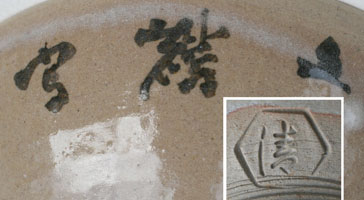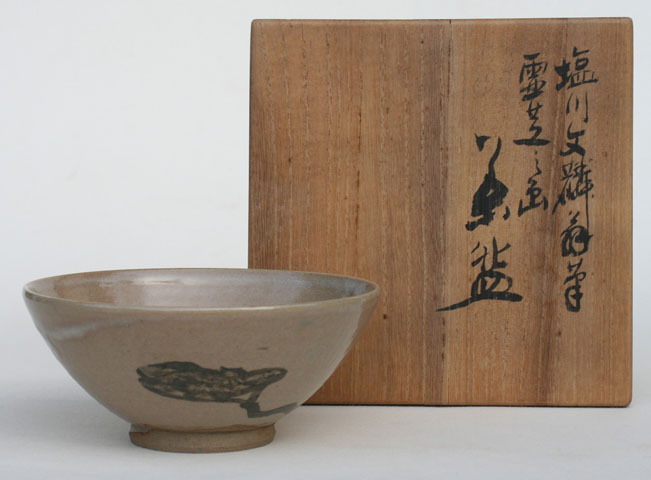Shijô Kyoyaki
Reishi chawan, teacup with reishiSigned: Bunrin sha
Seals: Kiyo
Technique: Wheel turned glazed brown kyoyaki with a black tetsu-e, iron oxyde underglaze painting. 5 Stilt marks marks at the bottom Ø 12,8 x 5,8
Box: Authorized by Rokubei V (1875-1959), the grandson of Rokubei III
Condition: fine
Reishi (Ganoderma lucidum), commonly known as Ling Zhi in Chinese, is a herbal mushroom known to have miraculous health benefits.
If any one artist created Nihonga it would have to be Bunrin. He walked the boundaries of the Maruyama-Shijô style and searched for new interpretations in the Nanga style. On top of that he experimented with new painting methods. Through Kôno Bairei (1844-1895), his major pupil, his influence reached well into the twentieth century.
Bunrin’s father was in the service of the Takatsukase family. When in 1820 both his parents died he was sent to Kyoto to study painting. Soon thereafter the head of the Takatsukase family recognized his talent and arranged a place in Toyohiko’s studio (together with a lifetime allowance of rice). He received his training in the Maruyama –Shijô style, but at least as important was his access to Toyohiko’s “mythical” box of copies.
Bunrin’s connection with the Takatsukase family, which was connected with the imperial court, might have had consequences if he had not moved to a rural village in Shiga from where he travelled and visited temples to study their collections of Ming paintings. Meanwhile he remained in contact with some of the imprisoned key figures of the loyalist groups.
Reference:
Roberts p. 11
Araki pp. 689-90
Kyoto '98 p. 280
Berry & Morioka ‘99 pp. 58-62
Berry & Morioka ‘08 # 66
Conant p. 321
Hillier pp. 335-338
Kiyomizu Rokubei III was the son of Rokubei I (1738-1799) and the younger brother of Rokubei II (1790-1860). The Rokubei family still is an important and successful family of potters in Kyoto. From early on they worked together with Shijô style painters. Rokubei I was befriended with Maruyama Ôkyo (1733-1795) and Go Shun (1752-1811).
Reference:
Roberts p. 130
Price: ON REQUEST

